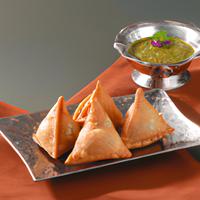
1 serving (150 grams) contains 300 calories, 5.0 grams of protein, 15.0 grams of fat, and 35.0 grams of carbohydrates.

Log this food in SnapCalorie

Nutrition Information
Calories |
480 | ||
|---|---|---|---|
% Daily Value* |
|||
| Total Fat | 24 g | 30% | |
| Saturated Fat | 4.8 g | 24% | |
| Polyunsaturated Fat | 0 g | ||
| Cholesterol | 0 mg | 0% | |
| Sodium | 640.0 mg | 27% | |
| Total Carbohydrates | 56.0 g | 20% | |
| Dietary Fiber | 4.8 g | 17% | |
| Sugars | 3.2 g | ||
| protein | 8.0 g | 16% | |
| Vitamin D | 0 mcg | 0% | |
| Calcium | 64.0 mg | 4% | |
| Iron | 2.4 mg | 13% | |
| Potassium | 320.0 mg | 6% | |
* Percent Daily Values are based on a 2,000 calorie diet. Your daily values may be higher or lower depending on your calorie needs.
Food Attributes
Source of Calories
About Hyderabadi samosas
Hyderabadi samosas, a popular snack from the rich culinary tradition of Hyderabad, India, are triangular pastries known for their crispy texture and flavorful filling. The outer shell is made from all-purpose flour, creating a flaky and crunchy base when deep-fried. The filling typically includes spiced mashed potatoes, green peas, and herbs like cilantro, with variations featuring lentils, minced meat, or other vegetables. The spice blend often includes turmeric, chili powder, garam masala, and cumin, offering bold, aromatic flavors. While Hyderabadi samosas are a treat for the taste buds, their health aspect depends on preparation. Fried in oil, they are calorie-dense and high in fats. Opting for baking or air frying can lower caloric content. The filling provides a source of dietary fiber and some essential nutrients depending on the ingredients, but moderation is key when enjoying this indulgent, savory delight.



